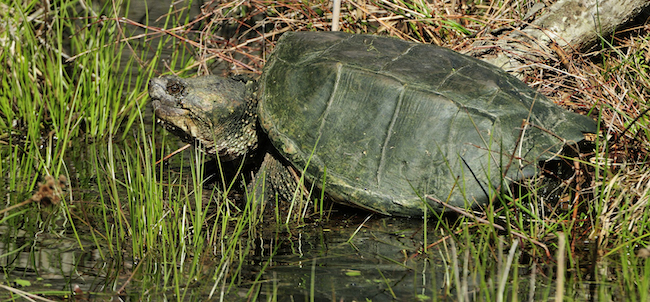Vol. 16 Issue 3, Fall 2011
By Nicole Hamilton
Common Snapping Turtles, North America’s snapping turtle, are the largest turtles we have in Loudoun and can live up to 40 years in the wild. At full size, their shells grow to 19 inches in length and they can weigh as much as 35 lbs. They can be found in muddy ponds, lakes, and shallow streams – and unfortunately, sometimes near roads.

(c) Photo by Jim Clark
Signature characteristics include husky heads, shields along their legs and tail, and small eyes with star-shaped pupils. Their nostrils are at the tip of their nose, acting like a snorkel so the turtle can rest in the mud and use its long neck to stick its head up for a gasp of air and remain inactive.
A snapping turtle’s diet consists of aquatic plants, fish, frogs and tadpoles, salamanders, insects, snails, leeches, worms, snakes, and small mammals. While camouflaged in the mud, the turtle will open its mouth, showing a small growth on its tongue that looks like a wriggly worm. As a fish comes by to investigate, it snaps it up! Snapping turtles have very sharp mandibles and strong jaw muscles. This, combined with their fast snapping action, provides them with a great ability to catch fish and other prey that move quickly through the water. Their long necks and quickness makes them a creature to approach with caution!
People often ask, “Do snapping turtles eat baby ducks?” and yes, being omnivorous they do, but they prefer the other foods mentioned and actually eat a lot of vegetation. They will also eat carrion (dead animals). An interesting fact is that snapping turtles sniff out carrion and have been used by police to find corpses!
In springtime, after heavy rains when it’s a bit easier to move on land, adults will move to new territories or search for places to lay eggs. Mating takes place in April through November and the female can store sperm for a few years, allowing her to lay her eggs when conditions are right. Eggs are laid in springtime and hatch in fall, with young often being eaten by herons, crows, raccoons, fish, and other animals.
Snapping turtles behave very differently in water than they do on land. In water, they are very comfortable, having broad webbed feet and good places to hide. They have great vision and can see and hear under water. Even with these advantages though, they are very shy and try their best to avoid people. Because the plastron (underside of the shell) is relatively small on snapping turtles, it doesn’t provide much protection, leaving their heads and limbs unprotected. On land in particular, they are very vulnerable. Because of this, when a predator or an unwise person tries to grab them, they pull out all the stops and defend themselves. This includes snapping or biting, hissing, releasing a foul odor, and standing tall on all four legs to look as fierce as possible. Contrary to what you might think, snapping turtles are actually gentle and shy creatures. They only act fierce to warn off creatures who venture too close. If you inadvertently have a close encounter with a snapping turtle, back off and maintain a respectful distance; it is simply a frightened turtle trying to save itself.
Snapping turtles are an important part of the ecosystem and should be left alone to play their role in ponds and waterways. But, there are situations where they get in trouble and need our help. If you see a snapping turtle in the road or about to cross a road, there are ways to move it without being bitten. Please call animal control or, if you are experienced in animal rescue, we have included an address for a YouTube video below demonstrating how to safely move a snapping turtle.
Sources and referenced video:
http://www.holoweb.com/cannon/snapping.htm
https://www.youtube.com/watch?v=Lgd_B6iKPxU

